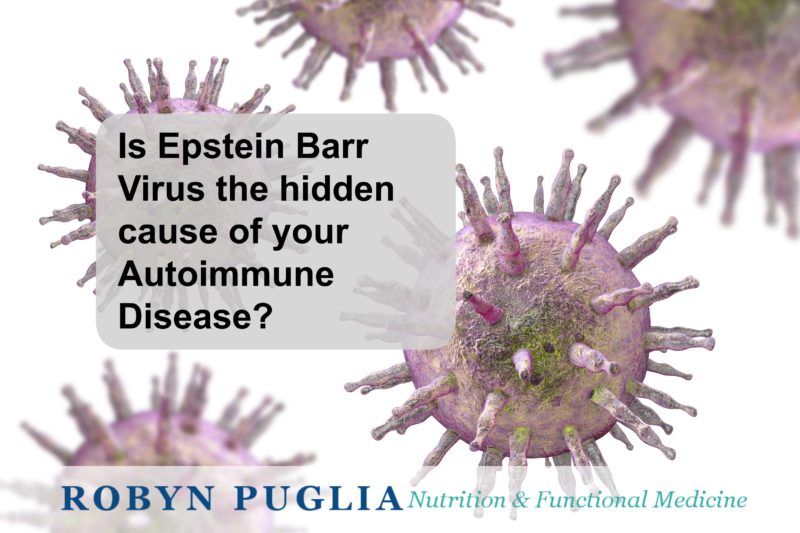Autoimmune disease is part of an overwhelming boom in chronic illness in the western world. There are more than 80 separate autoimmune diseases, and lots of other common illnesses, like cardiovascular disease for example, where autoimmunity is part of the development of the problem even though the disease itself isn’t considered an autoimmune disease.
The Triad of Autoimmunity.
It is generally understood, that to develop autoimmunity in the first place, you need to have three predisposing factors in place.
- Genetic Predisposition.
- Intestinal Permeability
- An environmental trigger of some kind.
Well, the reality is that it’s very common to have the genetic predisposition in some way or other. Some people have the specific genes required to develop a specific disease – e.g. HLA DQ2 and Coeliac Disease. And others may just have genes that predispose their immune system to mis-react in certain situations. The genetic component is actually not very black and white, there are lots of shades of grey in there, and remember that genetics are thought to contribute only about 20% to the outcome in most illnesses.
Intestinal permeability has been written about a lot. It’s incredibly common because it can be activated by stress, sugar, the bacteria in the gut, medicines, alcohol, foods. The list goes on really.
And then our third variable is environmental trigger, which may include stress, food proteins (e.g. gluten), toxins and infection, or infectious agents.
Epstein Barr Virus
Today I am going to be discussing one particular environmental trigger – an infectious agent, called Epstein Barr Virus (EBV). Some of your may have heard of it, but almost everyone has heard of the infection that it can cause; Glandular Fever, aka ‘Mono’ or mononucleosis, and also known as ‘the kissing disease’ because it easily spreads via saliva.
Aside from this infection, EBV is also associated with several very serious illnesses, including chronic fatigue syndrome (ME), Burkitt’s lymphoma and several autoimmune diseases including scleroderma, systemic lupus erythematosus, Sjogrens, multiple sclerosis and Hashimoto’s.
With autoimmunity, infectious agents can both trigger the illness in the first place, or they can perpetuate it once it’s already started. A significant way in this which occurs is that the body’s reaction to the infectious agent causes a level of inflammation over an extended period of time.
Inflammation when it’s appropriate is a good thing. It’s absolutely necessary to keep us alive and protect us against serious infection. But when it’s activated on a low level, for too long, it starts to cause damage to the tissue in the location it occurs (inflammation in the body is a bit like fire) and this begins a cascade of events that can end in autoimmunity.
Infection with Epstein Barr.
Epstein Barr Virus is actually a very common virus. You probably have it even if you’ve never heard of it. It is thought that about 95% of the population carry EBV and roughly 50% of us caught it by the time we were 5 with no symptoms, or mild symptoms, like a cold. (Remember, it’s transmitted via saliva and who shares saliva more than babies and toddlers? Possibly only teenagers.)
Of the remaining 50% who are infected as a teen or young adult, roughly 35% end up with the awful infection that we call glandular fever or mono.
Epstein Barr Virus Life Cycles.
EBV has two distinct phases to it’s life cycle. These are known as Lytic and Latent. The initial infection happens during the lytic phase and then once it’s in the body, it retreats into it’s latent form, where it is kind of hidden. However, it can revert back into lytic form in a process known as reactivation. This is interesting (at least, to me)and important to know, and I shall write more about it at a later date. It would make this post a bit long.
EBV, while common, has the potential to be seriously inflammatory and disruptive to the body (even in it’s latent phase). As an infection it has an incredible number of sneaky stealth strategies and defence mechanisms. Learning about EBV has had the distinct feel of reading science fiction at times.
How Epstein Barr Virus promotes Autoimmunity.
When you combine the effect that EBV has on the immune system, with the specific genes of the person with EBV and other environmental influences in that same individual, then it becomes possible for autoimmunity to occur. Research in this area is ongoing and new information is being published every year, along with more understanding about the subject. But here are four of the ways that EBV can trigger or promote autoimmunity.
1. Molecular Mimicry. Good intentions of the immune system, with an unfortunate outcome.
Molecular mimicry is pretty well understood by the scientific community as a way that bacteria and viruses trigger autoimmunity. From an immune perspective, MM is essentially a case of mistaken identity. The immune system basically mistakenly attacks part of the body, because it thinks it’s an infectious agent. They look similar enough to the immune system that this mistake is possible. When you get an infection, lets use chicken pox as an example, your body flags up a particular protein in the outer membrane of the virus as a way of recognising that virus in order to attack it. Now, proteins are essentially a long string of amino acids, and our bodies are also made up of lots of proteins. So if some of the protein in the virus and some specific protein in the body have a very similar string of amino acids – this can look the same to the immune system, who then attacks the body as well as the virus.
Well, with this mechanism, EBV has been directly connected with several autoimmune diseases including SLE (Lupus) and Multiple Sclerosis (MS).
2. Changes in Immune Communication.
The immune system is a massive information super-highway. It is constantly monitoring everything inside and outside our body in order to determine when to spring into action and defend us against something dangerous and life-threatening.
Part of the way it communicates is via chemical messengers and one class of these messengers are called cytokines. Different kinds of cytokines carry different messages, and late in the 20th century a new sub-class was discovered. This part of the immune system was named TH-17 (or T-helper cell 17), and the cytokine produced is called IL-17.
IL-17 and the TH-17 pathway has a very strong ability to stimulate both chronic and acute inflammation, and have not only been identified as significant in the development of autoimmune diseases, but are actually considered ‘pivotal’ in both systemic (e.g. Lupus) and organ-specific (e.g. Hashimoto’s or Coeliac) autoimmune diseases.
So where does Epstein Barr fit in here? After infection with EBV, the virus actually lives inside some very specific cells in the body. One of these cells is called a B-cell and it’s part of your immune system. Once EBV has taken up residence, it actually changes the messages that the B-cell sends to the rest of the immune system, and this results in increases in – you guessed it – IL-17 and the TH-17 pathway. Basically, infection of the B-cells with EBV can ‘push’ the immune system down the autoimmune pathway!
3. Localised Chronic Infection.
This one is fascinating to me! As well as changing the immune system in a ‘whole-body’ sense, EBV can also inhabit cells in specific tissues in the body, such as the gut or the skin. This drives inflammation and autoimmunity just in that area, without obvious consequences to the rest of the body.
Epstein Barr typically colonises B-cells as mentioned above, but also frequently inhabits another type of cell called epithelial cells. Specifically, EBV has been found active in salivary cells in Sjogrens, skin epithelial cells in Scleroderma and gut epithelial cells in refractory celiac disease as well as others. There have been studies done where they have researched the specific immune changes and resulting autoimmunity related to EBV in individual tissue.
4. Oestrogen, Vitamin D and Epstein Barr.
Another interesting pathway to autoimmunity involving EBV, actually starts with two common occurrences: Vitamin D deficiency and the increase of oestrogen found in pregnancy.
Vitamin D deficiency is so common, that unless you are taking Vitamin D supplements or work outdoors without sunscreen on, you are highly likely to have a Vitamin D deficiency. (When was the last time you had yours tested??). Pregnancy, while common, only affects half of the population, and even then only within a certain age range. So what do the two have in common?
Both Vitamin D deficiency and elevated oestrogen, such as that found in pregnancy, suppress part of the immune system that helps to defend against EBV, called CD8+ T-cells.
In conditions such as pregnancy, where oestrogen is high, CD8+ cells reduce in number.
One study from 2014 showed that Vitamin D deficiency had a significant impact on “the quantity, quality, breadth, and location of CD8 T cell immunity to viral and bacterial infections”.
CD8+ T-cell deficiency is a described feature of many autoimmune diseases, including Sjogren’s syndrome, SLE (Lupus), Ulcerative Colitis and Rheumatoid Arthritis.
So what I think is likely in this scenario is this. The individual is already infected with EBV (because 95% of us are), and when they then become Vitamin D deficient or fall pregnant, the changes in the immune system that occur as a result prevent the body from continuing to manage the infection. This creates an environment in the body where EBV can replicate properly and this further changes the immune system. You may add stress or toxic exposure or food reactions to this equation in order to reach frank autoimmunity, or just the increased numbers of the virus may be enough if the right genetic predisposition is present and the body is inflamed enough.
Because Epstein Barr is so common, I think it really needs to be considered as part of our internal ecosystem, rather than a rare infection. We need to think about how it fits in to the context of our immune system, because of the changes it is able to make, and also with other viruses and bacteria that make up the ‘microbiome’ of the body. We really need to stop thinking about these bacteria and viruses, including EBV as being somehow separate to us. We are all living together and when there is disharmony in our community, then disease follows. Part of reclaiming illness is working out how to redress the balance between human cells and microbial population so that there is harmony again. Because harmony (not eradication) = wellness.
Lastly, if you have an autoimmune disease, I think at some point you need to wonder if EBV was the original trigger? Or if it has reactivated and is preventing you from getting well again, even if it wasn’t the original trigger.
Have you been tested for EBV?
Do get in touch if you think EBV may be a problem for you.
Like to know more about this subject?
Here is a podcast I recorded with Naturopath Ben Brown on Epstein Barr and Autoimmunity.
Read about my 5-R approach to treating Autoimmunity.
Read about what it’s like having an Autoimmune Disease in our current medical system.
Get access to my free guide to better health while having an Autoimmune Disease.
Join my comprehensive and supportive program designed to lay the foundation for getting your health (and life) back where you want it to be.
References:
Poole BD1, Scofield RH, Harley JB, James JA. Epstein-Barr virus and molecular mimicry in systemic lupus erythematosus. Autoimmunity. 2006 Feb;39(1):63-70.
Selgrade MK, Cooper GS, Germolec DR, Heindel JJ. Linking environmental agents and autoimmune disease: an agenda for future research. Environ Health Perspect. 1999;107(Suppl 5):811–813.
McCoy L, Tsunoda I, Fujinami RS. Multiple sclerosis and virus induced immune responses: Autoimmunity can be primed by molecular mimicry and augmented by bystander activation. Autoimmunity. 2006;39:9–19.
Sfriso P, Ghirardello A, Botsios C, et al. Infections and autoimmunity: the multifaceted relationship. J Leukoc Biol. 2010;87:385–395.
Mei-Ru Chen Epstein–Barr Virus, the Immune System, and Associated Diseases. Front Microbiol. 2011; 2:5.
Michael P. Pender. CD8+ T-Cell Deficiency, Epstein-Barr Virus Infection, Vitamin D Deficiency, and Steps to Autoimmunity: A Unifying Hypothesis. Autoimmune Diseases. Volume 2012 (2012), Article ID 189096
Yuzefpolskiy Y1, Baumann FM1, Penny LA1, Studzinski GP2, Kalia V3, Sarkar S3. Vitamin D receptor signals regulate effector and memory CD8 T cell responses to infections in mice. J Nutr. 2014 Dec;144(12):2073-82. doi: 10.3945/jn.114.202895. Epub 2014 Oct 15.







